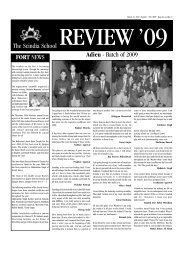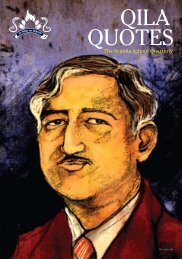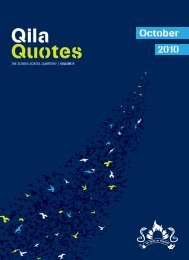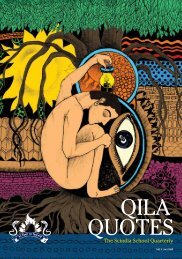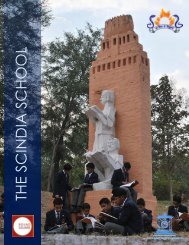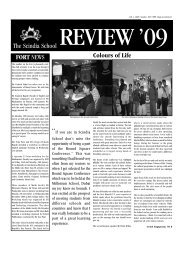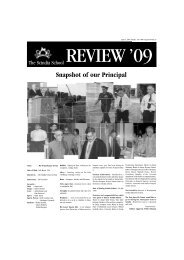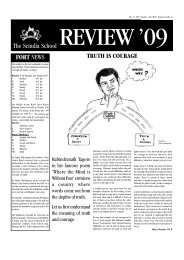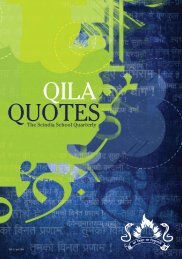16th July 2011 - The Scindia School
16th July 2011 - The Scindia School
16th July 2011 - The Scindia School
Create successful ePaper yourself
Turn your PDF publications into a flip-book with our unique Google optimized e-Paper software.
QILA QUOTES | <strong>The</strong> <strong>Scindia</strong> <strong>School</strong><strong>The</strong> FounderMaharaja Madhavrao Jayaji Rao <strong>Scindia</strong>Board of GovernorsPresidentH.H. Maharaja JyotiradityaM. <strong>Scindia</strong>MembersShrimant Rajmata Madhaviraje <strong>Scindia</strong>Mr. Vinay Kumar ModiMr. Mahesh GandhiMr. Arun KanodiaMr. Harpal SinghMr. Rajendra S. PawarMr. Arun KapurMr. Kapil DevMr. Bharat V PatelMr. Anurag BansalMr. Vivek Narayan ShejwalkarLt. Gen. (Retd.) S.P.S. DhillonMrs. Sujata BarmanSecretary/PrincipalMr. Samik GhoshVice - PrincipalMs. Shalini MehrotraBursarLt. Col. R.D. Sharma<strong>Scindia</strong> Old Boys'AssociationPresidentLt. Gen S.P.S. DhillionVice PresidentMr. Vikram MathurMr. Gopal BhargavaTreasurerMr. K.M. AgarwalSecretaryMr. Prashant GangwalJT. SecretaryMr. Sandeep AgrawalcontentsPrincipal’s MessageEditorialStudents’ AchievementsOld Boys’ NewsReminiscencesA teacher who had a deep Impact on youAlumniDOGS (Part of a book on pets, ‘Living with Humans’)Amitabh Naik, Ex Rn 1962FacultyInternational Leaders in Education Program an EducativeExperience of a Life TimePrashant Chaturvedi, Faculty of Social Studies, <strong>The</strong> <strong>Scindia</strong> <strong>School</strong>InterviewYadu Sankalia (Ex Ja, 1980 )with Kanav Viren Barman, Senior Editor(Student) Review/Qila Quotes.LiteraryFrance, Je t’aime… Memorabilia!!!Aditya Sharma, X AAnnual English Play 2010-11<strong>The</strong> Kingdom Of CardsTuhin Pandey, XII DTimeless-Some things Never ChangeA Midnight Adventure - 1971Dinesh Malhotra, Extract from the <strong>School</strong> Review,Issue 409, 15th March 1971.A Midnight Adventure - <strong>2011</strong>Karan Kapoor, XI A<strong>July</strong> <strong>2011</strong>Every effort has been made to ensure the accuracy of theinformation printed in this edition of Qila Quotes. If an errorhas occured, please accept our apologies and contact theeditor at pujap@scindia.edu.
QILA QUOTES | <strong>The</strong> <strong>Scindia</strong> <strong>School</strong>Principal's DeskA student takes away a wealth of experience andmemories as he goes through life at <strong>The</strong> <strong>Scindia</strong> <strong>School</strong>.Two most important of them are his association with theteachers and the moments shared with the friends.Mr. Samik GhoshPrincipal, <strong>The</strong> <strong>Scindia</strong> <strong>School</strong>I was recently asked by one of the students as to how I distinguished between a goodboy and one not so good. After being a teacher for almost 30 years I found it a difficultquestion to answer. Do we really make such distinctions? Perhaps not and certainly notpermanently; they all are boys in the end, some mature early some a little later in life. Weremember their pranks as much as their good work and remember them with affection. Thiscore spirit of the life at <strong>Scindia</strong> is captured in several articles of this issue of Qila Quotes.Ronit Borpujari, Rohit Rathi, Mrs. Sujata Aslam and Kshitij Jain infront of Seckford <strong>The</strong>atre at Woodbridge <strong>School</strong><strong>The</strong> Old Boys’ contributions are informative and thought provoking. We shall find reflectionsby the teachers about their experience of education in other countries.I expect to see you on Founder’s Day.<strong>The</strong> <strong>Scindia</strong>ns with the Suryodaya Fest ’11 trophy04volume 12july <strong>2011</strong>
QILA QUOTES | <strong>The</strong> <strong>Scindia</strong> <strong>School</strong>Editorial<strong>The</strong> beginning of the quarter (April-June) was marked by excitement as the students lookedforward to going home for a long summer break. However there was never a dull moment asthe annual English and Hindi plays, the Junior House reports and Junior House evening justbefore the closing kept the school throbbing with activity.<strong>The</strong> evaluation test at ‘French in Normandy'Labour work at Tighra dam<strong>The</strong>re was also enough to keepthe students fruitfully engagedduring the vacations what with thesummer study camp for classesXI and XII, student exchangeprogrammes, summer expedition,French educational excursion andof course the holiday homework toensure that all utilize their holidaysproductively.Infrastructure<strong>The</strong> admin machinery has been going at full throttlethroughout the summer. It was a race against time tocomplete all construction and renovation before the termcommenced. <strong>The</strong> momentum will however carry on inkeeping with the directions of the Board of Governors andresolution to upgrade facilities in the school to the higheststandards.Our green team has also been busy. In collaboration withthe staff and students, this year we will institute a plantationand greening drive. We have been promised support from‘Nanhi Chhaan’ Foundation which promotes welfare of thegirl child and also the protection of the environment.Exchange ProgrammesMrs. Sujata Aslam went to Woodbridge <strong>School</strong>, UK ona regular teacher exchange programme. <strong>The</strong> Woodbridge- <strong>Scindia</strong> partnership which got an impetus last year hasbeen put on a firmer platform this year. Mrs. Aslam involvedherself extensively in the English, German, Drama andReligious Studies classes. She has returned with usefulmaterial for the English Department in the form of languageworksheets, books and audio books. Five areas havebeen identified for collaborative projects between the twoschools.Eight students went on educational exchange to differentschools in UK and South Africa. <strong>The</strong>se programmes haveproved very beneficial as International learning broadensthe outlook of the students. <strong>The</strong>y return with great maturityand tremendous sense of accomplishment.For the fourth year in succession two students went toGermany on a 100% scholarship. <strong>The</strong> exchange which isa part of the PASCH project (Schulen Partner der Zukunft)offers students a wonderful opportunity to hone theirlanguage skills and get a first hand experience of Germanculture.Fifteen students along with Ms. Renu Pandey went on aFrench educational excursion to Rouen. <strong>The</strong> studentscame back enriched as apart from enhancing theirknowledge of the French language they also imbibed theFrench culture by visiting museums, cities, institutions andby staying with French families. (Detailed report on page17)EventsNine schools participated in the Suryodaya Fest ’11hosted by <strong>The</strong> <strong>Scindia</strong> <strong>School</strong>. This year the theme was ‘ICTin Education’. <strong>The</strong> fest consisted of eight challenging eventswhich tested the skill and creativity of the participants. <strong>The</strong>Suryodaya Fest Overall running trophy of excellencein IT was awarded to <strong>The</strong> <strong>Scindia</strong> <strong>School</strong> for thesecond year in successionActivitiesResponding to the appeal made by the Gwalior ZilaPanchayat , a team of 113 students of Classes XI andXII and fifteen teachers went to the Tighra Dam forShramdaan on 8th May. <strong>The</strong> students and teachers workedwith great organisation and enthusiasm braving the sun toremove mud from the sides of the water body. This is ourcommitment towards maintaining the main source of waterfor the city. This venture was widely appreciated.AcademicsHeartiest Congratulations to Palaash Bhargava for toppingthe school in the Class XII Board examination. A specialword of appreciation for Jivitesh Mazumdar for securing100% in Fine Arts. We are proud of Nipun Jain for havingachieved the astounding CGPA of 10 in Class X. We hopethat many more <strong>Scindia</strong>ns will replicate these outstandingscores in future.<strong>The</strong> Summer Study Camp for classes XI and XII washeld from 25th April to 14th May. Over a period of threeweeks around 30% of the syllabus was covered and thestudents were tested on it in the last week of the camp. <strong>The</strong>supervised prep time in the evening and the study time atnight were diligently followed. <strong>The</strong> students got adequatetime for revising the portions taught in class and also forclarifying any doubts that they may have had. <strong>The</strong> studentsand teachers went for the holidays with a definite sense offulfillment.With a view to revamping academia and making it morerobust the teachers reported back to school in the mid ofJune. With great enthusiasm the entire faculty sat together,discussed, deliberated and came up with plans for thecoming year. Effective teaching learning strategies forboth the middle as well as the senior school level werediscussed. After several brainstorming sessions policieswere framed keeping the academic progress of students inmind.Faculty NewsWe bid adieu to many members of the faculty who leftus to take up greater responsibilities in other institutions.Number of qualified teachers have been inducted. Wehope they have a fruitful and fulfilling stay here. Lt. Col.R.D. Sharma has taken over as the Bursar. Mrs. RakhiSharma has taken over as the Head of Middle <strong>School</strong>.Career Cell<strong>The</strong> career counseling cell organized a workshop for classesXI and XII by a Delhi and Mumbai based organization ‘OneStep Up Educational Services’. It gave the studentsindepth information on a wide range of careers. <strong>The</strong>students responded enthusiastically and had their queries,regarding the university, answered for specific career optionsboth in India and abroad.Principal Mr Ghosh with the members of the HH team<strong>The</strong> <strong>School</strong> hosted the 9th H.H. Maharaja Madhavrao<strong>Scindia</strong> Memorial Cricket Tournament for the year<strong>2011</strong>. Seven teams participated in the tournament. Eachday brought great excitement with excellent cricketing skillson display. Y.P.S. Patiala lifted the cup.06volume 12july <strong>2011</strong>
QILA QUOTES | <strong>The</strong> <strong>Scindia</strong> <strong>School</strong>ReminiscencesA teacher who had a deepimpact on you.One teacher who had a profound impact on my life was our Physical TrainingInstructor, Mr. Jacob. He was in Junior <strong>School</strong> in 1957-58, when I was in class IIIand IV. I was fascinated by his calligraphy and the single line figures of humanactivity he sketched. This later encouraged me to caricaturing and drew me to finearts, even though I studied to become a chemical engineer. To this day, when I ampast sixty I remember him as the first major influence that shaped my life.Jayant Gaur, Ex Md 1966No doubt, it was Mr K.G.Gaur, my Mathematics teacher inclass VIII. I was filling up my forms for the class XI exams(Cambridge Course), when I had a nagging doubt about themarks of my sixth subject (the best five of six were countedfor tabulation), being a little weak in Chemistry. I went upto Mr. Gaur and asked him if he would coach me for theMathematics paper (remember just a couple of monthsto go before writing my final papers, and the entire threeyear course to be completed). Without batting an eye-lid,or for that matter flinching at the thought, he just took onepromise from me, that I would be willing to put in that extralabour and even forgo my games-time. This was just thestraw I was looking for, and promised. He took my lessonsat the games-field, while he supervised sports activity. Thistaught me the lesson on devotion- devotion to your cause. Ihave been following this ever since, in whatever I do in life,particularly for my healing work.How can I forget "Daddy" Devi Shankar? As myHousemaster he, along with Madam treated us like hisown children. <strong>The</strong>y took care of even our smallest ofrequirements and never let us feel that we were far awayfrom home!Naresh Mantri, Ex Rn 1968Mr Agnihotri was very knowledgeable and an excellentteacher. He was a caring and loving House Master who lefta lasting impression on our young and adolescent minds.May his soul rest in peace.Pankaj Dwivedi, Ex Ja 1968Mr. Khar, our Chemistry teacher, quite often took the pupilsthrough the lesson by asking leading questions. If you gotthe right answer he would say had you been born earlier,your name would have been there instead of Gay Lussac (orthe name of the eminent chemist responsible for finding outthe same chemical principal). For me, it developed a habitof asking questions related to the basics of any problem,(situations, religious or conventional customs, behaviour,etc). This often gave me an understanding of why a systemworked or was being followed. It has also made me moretolerant and capable of handling stressful situations.Ravindra Datar, Ex Ja 1970I was deeply influenced by Mr. Pawar, the Vice Principal wholectured me on the importance of trees after he saw mebreak a branch while swinging from it. I guess it was my firstlesson on the conservation of environment.Deepak Kaul, Ex Mj 1973<strong>The</strong> basic impact of Mr. Atma Ram Sharma on my life wasdue to his simplicity and nonchalance towards what othersthought and talked about him. His ability to relate to thestudents at their mental level was amazing. In fact imbibingthis quality helped me a lot in my professional career.Another thing which was great about him was his abilityto crack jokes on himself and not getting angry even whenwe students joked about him. In fact he used to laugh andmade sure to throw that joke back on us so that we feltstupid. I remember, before every class of his we used todraw a parrot on the black board as he was nick named(Mrs.) Bishnoi (Faculty) dispensing her popular homeopathic medicines to the students‘Tota Ram’. But Sir was amazing. He used to draw a chillyin front of the parrot by saying that the parrot was hungry. Itwas great fun to attend his classes. Once I told him jokinglythat I was sleepy. He made sure that I closed my eyes andput my head down on the desk. I was thrilled and thoughtthat I had made a fool of him, not realising that he ensuredan extra class for me to cover up for that period. That wasthe first and the last time that anyone in our class wantedto sleep. This taught me another lesson, which was not toever consider the other person a fool.I could go on and on with the tit bits as anything andeverything he did was humorous but enlightening at thesame time.R K Jain, Ex Ja 1975Apart from all the respected teachers we had in ourtime, Mr. S.P. Sahi, the <strong>School</strong> Principal, was a thoroughgentleman whose teachings are deeply etched in my mindtill date. He was an excellent teacher and a very ableadministrator.Pankaj Bhargava Ex Ja 1977, Ex Vice President SOBA2002-03Mr. Hughes, our History teacher, believed that history wasn’ta subject that should be read out of a book or 'mugged.'It was about learning why events took place and what theirconsequences were. He taught us the first battle of Panipatwith battle formations and why Babur managed to defeatthe Lodis despite having a smaller army. This has helped meto constantly strive to research a situation before taking adecision.Yadu Sankalia Ex Ja 1980Dr. Singh for his personality, administrative skills andprogressive thinking. Mr. Khan for encouraging me in Math(and Hockey!)Amitabh Malhotra Ex Md 1986Mr. Bakshi……. the name says it all.Vivek Mukherjee Ex Ja 201010volume 12july <strong>2011</strong>
QILA QUOTES | <strong>The</strong> <strong>Scindia</strong> <strong>School</strong>AlumniDOGS(Part of a book on pets, ‘Living with Humans’)Dogs are probably the only pets that Indians keep. Without statisticsavailable and going by personal experience, I can only assume that thosewho do have cats are so few that I can exclude them in generalizing aboutpets without them protesting.Amitabh NaikEx Rn 1962It has, in fact, become so fashionable to have dogs aspets, that even amongst the slum dwellers, Sherus andKalus, AND, BELIEVE ME, TOMMIES, too, can be found. Andyet most of us know very little about them. This shouldnot come as a surprise for in the existing cultural milieusomething which does not translate into money or upwardmobility is a waste of time. Being the eternal optimist, asall writers are, I feel that there are some who would like toknow a little more than just the name and pedigree of thebreed of their pet dog or the brand name of dog food of Mr.Ambani’s (and people like him) pet.<strong>The</strong> theory that dogs were domesticated by humans inpre-historic time does not hold water. Wolves becameassociated voluntarily with the roaming hunting tribes,eating what the humans left behind, as ‘<strong>The</strong> Stone Age’,hunters (15,000 years ago), may have found them usefulfor picking up animal scents warning them of imminentdanger. Our domestic dog breeds extend no further backthan the books of various breeding organisations, or otherartistic or written records. A few skulls, their fragments, orteeth are all that we have of the pre historic dogs; so it isalmost impossible to claim that some present-day breedsoriginated in the Stone Age: the evidence is simply notthere.Wolves were domesticated by man around ten thousandyears ago, and their life in captivity and human protectionrapidly changed their characteristics. This was more as aresult of selective breeding. Modern dog breeds have littlein common externally with each other, but they all retain thebasic anatomical structure of their wolf ancestors.<strong>The</strong> aggressiveness found in some breeds is not becauseof their ‘Wolf Blood’, but resulted once again from selectivebreeding.Domestication has also affected the internal anatomy of thedog. <strong>The</strong> domestic dogs have a brain which is 30% smallerthan wolves (sorry, dog lovers), and the eyes, ears and noseare less sensitive. Even the best tracking dogs are no matchto the fine sensitivity of the wolf, thanks to human company.However, there is good news, a small brain does not meanless intelligence; it is only that living with a human family,the dog’s senses do not need the same sensitivity as thewolf, which has to survive the rigours of the wild on its own.Dr. Bernhard Grzimek, renowned zoologist, found in hisexperiment that a wolf took just five minutes to determinewhich of the several covered pans contained meat, whiledogs took over an hour to do the same! To add insult toinjury, a wolf can relocate meat hidden underground afteras much as sixteen hours, when it is almost impossible tosmell the meat, our dear Tommy doesn’t waste time in suchactivities.Definite indication of domestication of dogs can be found inAsia Minor and Egypt, around 4000 years ago, but it in noway concludes that our ‘Dog’, descended from these dogs.<strong>The</strong> Australian Dingo was first thought to be a wild canid,is now known to be a feral dog (a domesticated dog thattakes to the wild). It is unfortunate that today there are, fewpure Dingos in Australia, most of them in zoos. However,these dogs retain their wolf ancestry.Ownerless and to some extent feral domestic dogs canalso be found in the Balkans, Asia Minor, Northern AfricaSoutheastern Asia. <strong>The</strong>se Pariah dogs are not of a uniformrace like the Dingo though. <strong>The</strong>y are probably descendentsof the older domestic races that occasionally ‘crossed’, witha modern breed. <strong>The</strong>se dogs are responsible for the breedof dogs with almost no hair! <strong>The</strong>se mutants can claim to beof a superior race as humans consider less body hair as asign of cultural heritage.<strong>The</strong> <strong>Scindia</strong>ns with one of the many adopted dogsToday there are almost four hundred recognized dog breeds.However according to experts the division of domestic dogsis questionable. It would be more appropriate to categorizedogs in terms of how they are used, or misused, therebyconsidering their essential biological features.This brings us to the vital question what is the role of adomesticated dog and what is the best way to live with it.Dog lovers not only here but throughout the world have forlong emphasised that of all domestic animals dog is closestto man, his ‘best friend.’ This is not entirely because of man,the dog stays with his master or human family, just as hiswild ancestors lived as a part of the pack. <strong>The</strong> social drive indogs is part of its wolf heritage of living in packs with a welldefined dominance hierarchy. Since domestic dogs do notlive in packs, the master or family serves as a substitute. Ifthe dog is handled correctly, it treats people as superior inthe rank order and will respond as a subordinate. If not thedog will, from its viewpoint, fight for its social class. Thosewho do not know, consider this behaviour as disobedienceand attempt to stop this behaviour by force. This only resultsin more disobedience as the dog instinctively begins todevise ways to outwit the tyrant.Obedience and disobedience apart, a domesticated dogbehaves towards the master, in the same way as it did asa pup towards its parents. This prolongation of juvenilebehaviour throughout adult life is the real reason behind thefaithfulness in the domestic dog.Dog behaviour is based on both its innate instincts andon its memory (its experiences). <strong>The</strong> dog is capable oflearning within these behavioural patterns, and therefore anaggressive dog can be taught to let an ‘enemy’ pass withjust a growl and no attack. <strong>The</strong> dog shows its obedienceto the master and yet asserts its social position. If oneunderstands just this one characteristic no trainer is needed(social climbers may disagree), for the pet. In fact, a trainermakes the dog more confused and robotic in its behaviour,a thing a dog lover should never tolerate.12volume 12july <strong>2011</strong>
QILA QUOTES | <strong>The</strong> <strong>Scindia</strong> <strong>School</strong>FacultyPrashant ChaturvediFaculty of Social Studies<strong>The</strong> <strong>Scindia</strong> <strong>School</strong>International Leaders inEducation Programan Educative Experience ofa Life TimeOn the fateful day of the 4th of January <strong>2011</strong> seventy four teachersfrom 15 countries around the world gathered in Washington DC for theInternational Leaders in Education Program (ILEP).ILEP is a program of the Bureau of Educational and CulturalAffairs of the US Department of State, implemented byInternational Research and Exchanges Board (IREX).Initiated in 2005, ILEP brings outstanding secondaryschool teachers from around the world for approximatelyfive months to the United States to further develop theirexpertise in their teaching areas, enhance their teachingskills, and increase their knowledge about the US. <strong>The</strong>selection process is both rigorous as well as democratic.This year seven teachers represented India. I felt pride inrepresenting India and my school.During the three-day welcome session, fellows –asteachers are called-participated in sessions which dealtwith Cross –cultural Communication and Service learning.Cross- cultural communication was essential to smoothenthe process of our adjustment. <strong>The</strong> ‘iceberg metaphor’ wasused to drive home the concept. Just as nine tenths ofan iceberg is below the surface of the water, so is a largeproportion of culture out of conscious awareness. One'sinitial impressions of a culture are based on what one sees,hears, feels, tastes, and smells. This primary awareness isjust the tip of the iceberg. In-depth awareness is developedover time as one scans the environment and gains a deeperunderstanding of the host culture. This happens only whenwe suspend one's own values, beliefs, and assumptions,seek alternative viewpoints, and understand host country'sbehavioral norms relative to that culture.Another interesting feature of discussion was that ofservice learning. It is a teaching method that combinesservice to the community with classroom curriculum. Itis more than merely community service. It is a hands-onapproach to mastering subject material while fostering civicresponsibility. Service-learning builds stronger academicskills. First, students take an active role in determininghow the projects are identified and accomplished, creatinginterest and excitement for learning. Second, servicelearningaccommodates many different learning styles.For an example, as part of a history class, middle schoolstudents conducted research on the history of theircommunity and wrote stories that were then displayed atthe town hall. <strong>The</strong> students interviewed townspeople andvisited local libraries to collect information. In addition toenhancing their writing and research skills, the studentsgain an understanding of their community history throughtheir work and the subsequent classroom reflection.Five universities namely James Madison, Clemson,Huntsville, Kent and Northern Kentucky participated in theprogram. I was in the Northern Kentucky University. <strong>The</strong>rigour of the programme was felt soon after our arrival. <strong>The</strong>fellows were expected to be in the university at 8:15 a.m.despite the weather conditions. <strong>The</strong> only exception could bea tornado alert. Coming five minutes early was consideredto be on time, reaching at the prescribed time as late andarrival after the given time to be impolite! <strong>The</strong> classes wenttill 10:45 am. We were to arrive again around 4:15pmwhen we had an evening class which lasted till 7:15pm.<strong>The</strong> schedule tightened in February when we had a monthlong internship in a school. In our free time we were busycatching up with assignments given at the university. Takingand giving help was an accepted norm since no one personwas an expert in everything. <strong>The</strong> university celebrated aninternational coffee hour every month and the fellowswere expected to make a PowerPoint presentation on theircountry.Mr. Prashant Chaturvedi before the convocation ceremonyI chose to be in a course titled ‘Leadership in Education’.It was intended to make teachers teach better and todevelop their skills to become future leaders in education.This concept of leadership was taught through the idea ofprofessional learning communities which means educatorscommitted to working collaboratively with an ongoingprocess of collective inquiry to achieve better result for thestudents they serve.Another course that I was enrolled in was ‘Learning acrossCurriculum’. In this class literacy strategy across the subjectareas was discussed. <strong>The</strong>se techniques were intended tooffer teachers and students a flexible set of ways that canhelp connect and support learning in their content areaand guide students toward independence in the use ofthose strategies. A wide array of subjects was covered inthese strategies which we as a school can adopt to enrichour teaching. It will be worthwhile to elaborate on a few ofthese.All of us had to attend a technology class too. Topics thatwere covered were wide ranging. <strong>The</strong>se extended fromMS Word, PowerPoint, and Excel to other more interestingsoftware. One such innovative programme that I learnt waspodcasting. At <strong>Scindia</strong> we can use podcasting for childrencompeting in elocutions and debates.‘Google Earth’ is another tool which can be used inclassroom teaching. For instance, in math children canuse it to measure the length of airport runways, bridges,buildings, swimming pools, distance between gas stations,height of famous buildings etc.I taught at Boone County High <strong>School</strong> for a month duringmy internship. I was given grade 11 to teach. Students inall such schools are grouped according to their abilitiesand the ‘Advanced Placement’ students are considered thebest. Apart from the regular curriculum they also take afew credit courses to gain extra credits to get admission inbetter universities. Knowledge about other countries andtheir cultures is poor. I was particularly surprised to see thatthe students wait full time in their classes and move aboutonly when the duration of the class was over. Any aberrantbehavior of a student is dealt with an initial counseling andif that does not work it calls for suspension.I was happy to see that my partner teacher Mrs. AlisonSutton was very enthusiastic about her classes. I observedher use a three pronged technique to deliver Americanhistory. Firstly, she introduced the topic by writing theimportant points on the white board. <strong>The</strong>se were thendiscussed by inviting children to question or even at timesprovoking them to speak up. She then showed them amovie clipping related to the topic. For instance, whileteaching about the massacre of the Red Indians sheshowed them ‘Buffalo Soldiers’. She kept on pausing,interrupting every now and then to add her comments. Afterthe movie excerpt a sheet of paper was handed over toanswer some short questions. Students enjoyed respondingto them because the questions though simple were tricky.This compelled them to apply their mind to minute butinteresting details. I believe this is a happy combination tomake history interesting to all.One meaningful strategy is ‘Web Page Evaluation.’ <strong>The</strong>objective is to help students evaluate information theyobtain from the internet. <strong>The</strong> teacher or students decide ona topic to investigate or research. <strong>The</strong>n the teacher displaysa checklist and explains to the students that they will useit to compare and evaluate internet sources. <strong>The</strong> teachermonitors the students in their online research asking themto think critically each page they find by putting variousquestions to them like what type of domain is it? Aresources well documented? Who is the publisher? Does the I thank my school for allowing me to have such anpublisher make sense? Does it correspond to the name of educative experience which has revolutionized my teachingthe site? Why is the page put on the net? Who links to this forever. Allow me to close with a quirky comment. In USA itsite? Is the information as good as other sources? I believe is difficult to buy a ‘Made in USA’ product. After all Americathat children should be made aware of being critical to what is ‘Made in China’!they surf on the net and not to take every written word assacrosanct. This exercise will help them hone their skills inall subject areas.14volume 12 | july <strong>2011</strong>volume 12july <strong>2011</strong>
QILA QUOTES | <strong>The</strong> <strong>Scindia</strong> <strong>School</strong>InterviewYadu Sankalia (Ex Ja, 1980 )with Kanav Viren BarmanKanav Viren BarmanSenior Editor, ReviewCould you explain the name of your NGO, <strong>The</strong> KishkindaTrust (TKT)?<strong>The</strong> name <strong>The</strong> Kishkinda Trust comes from the Ramayana.<strong>The</strong> mythical Kishkinda is believed to be the kingdom of theVanara king Sugriva, the younger brother of Bali. He ruledhis kingdom with the assistance of his minister Hanuman.<strong>The</strong>re is a temple dedicated to Hanuman called Ajanadriwhich is said to be his birthplace.No, there are not enough volunteers. People like me wouldlove to stay in Annegundi for six months (the minimum timerequired to make a difference) but other pressures do notgive us the time. Yes they are hard to come by and a lot ofthem from the Social Institutes XLRI, TISS etc would ratherwork with some of the better known NGOs. However TISS isworking with TKT now.Do the volunteers benefit from working with TKT?What role do you play in <strong>The</strong> Kishkinda Trust? (TKT) Howdid you get involved?I am not involved on a day to day basis. However, I ammore interested in social empowerment. By this I meanthat we should strive towards giving / getting opportunitiesof employment to the villagers closer to their place of stayrather than providing them employment in larger towns.Since I have been closely associated with handicraftsfor a number of years the founder member of the Trust,Ms.Shama Pawar, asked me to help identify what could beproduced in the area. In the absence of a traditional craftwe looked at what was grown in abundance there. Thishappened to be banana (the details are on their website).<strong>The</strong> seed of an idea was given to them and over the yearsthey have produced numerous articles from the fibre ofthe banana bark. I now help them with marketing of theproducts and giving them new ideas.I strongly believe that we should reduce our dependence onman made fibre and articles. I make a consistent effort toreduce my personal carbon footprint in every way possible.To take this further the Founder of the trust, Ms ShamaPawar, and I are now exploring ways in which we can helpother organisations with the same mind set.Tell us something about Ms. Shama Pawar, the founder.How would you describe her?Friend, dynamic, does not believe in the word 'no' or‘impossible'. She believes in what she is doing and is singlyat her work.Do enough people volunteer for TKT or are trulyenthusiastic volunteers hard to come by?<strong>The</strong>re are two kinds of volunteers – the ones who are doingthis as part of their syllabus and the others who want todo this for the experience and to make a difference. Bothkinds benefit. One gets to work at the village level and seethe highs and the lows of village life, our complete neglectof our heritage, our disregard for nature etc. When oneworks at any NGO, not necessarily TKT, one does benefit.However, the benefit accrual is within oneself and cannot bemeasured in terms of marks for an examination.Do you think <strong>The</strong> <strong>Scindia</strong> <strong>School</strong> played a role in steeringyou towards social work?I would say it is the whole experience of childhood. Parentshave an important role and so do the teachers and themilieu in which you are raised. My parents have alwaysinstilled in me the virtue of humility, to see the thingscarefully and not be afraid or ashamed of what is presentaround us.When in <strong>School</strong> we had to wash our own toilets once amonth and also had the labour camps. But I still think it ismore of a personal belief. You might have the right milieubut still may not absorb it.Your trust carries work in so many diverse fields likeWomen’s Empowerment, Conservation, Education etc.How do you manage? Are donations forthcoming ordifficult to manage?<strong>The</strong> Trust has independent people managing and lookinginto these various aspects. Do not forget that they are allinterlinked at the same time.Donations are hard to come by. TKT works more with thegovernment institutional grants which are given on the basisYadu Sankalia (Ex Ja 1980)of performance. <strong>The</strong>se grants are disbursed across verycarefully so that all segments are looked after. However wefeel someone volunteering time is also giving a donation!Is there any particular success story that you would liketo share?I take the Banana Fibre story as a success story. From agerm of an idea twelve years ago we have given employment-direct and indirect- to 300 women in the area. On anaverage they make 2500 to 3000 per month from workingin this segment. We export the goods and also sell themacross the country in numerous boutique stores.What kind of awareness programmes do you have for thechildren?<strong>The</strong> awareness is more through dance, craft and field trips.Dance - developing social and cultural heritage, Street Plays- on social issue like hygiene, and preservation of heritage,Craft - making of paper masks, hangings etc.All the above are carefully interlinked with fun andawareness of one’s surroundings and are not taught ina bookish manner but more with fun and a hands onapproach.What do you have to say about the satisfaction of doingwork for the economic upliftment of the poor? Don’t anyselfish motives come to mind?Immense satisfaction. Why can’t we constantly give back?How much do we need to live? We live in a world where peerpressure is everything. One doesn't have to have millions andzillions in the bank or under your mattress to enjoy life!Actually the only selfish motive that comes to mind is givingback to society.Please let me know if the school would like to send somestudents there for a month to experience first hand social workand the beauty of that area.16volume 12july <strong>2011</strong>
QILA QUOTES | <strong>The</strong> <strong>Scindia</strong> <strong>School</strong>LiteraryFrance, Je t’aime…Memorabilia!!!<strong>The</strong> French educational excursion began with a germ of a thought and ended leaving uswith memories of a lifetime. One day during the French class, our teacher, Ms. Renu Pandeytold us that those of us interested would get the opportunity to go to France for a course inFrench language.Aditya SharmaX A<strong>The</strong> trip was organized by a Delhi based company‘Education & Beyond’ with the full support of the FrenchEmbassy. A group of fifteen students along with Ms RenuPandey were off for this amazing experience.On 23rd May, <strong>2011</strong>, we assembled at Indira GandhiInternational T3 gate number 6 for the journey. We werethe league of Indian gentlemen with French survival phrasebooks in hand, dressed in the T-shirt given by the Frenchembassy which read ‘Je parle Français’ (I speak French).Soon we were on Gulf Air aircraft headed for Bahrain. Wereached there in the evening and after six restless hours atthe airport took the connecting flight to Paris. We reachedFrance the next morning.As the aircraft descended, the beauty of the city bewitchedus. Jet lag was forgotten in the excitement of havingreached. Our group escort, Mrs. Kirti Sharma got in touchwith the contact person at the airport and soon we were offfor a little sightseeing in Paris. Famous as it is for its richart, architecture, culture and widespread fashion industryalong with the exotic cuisine there was much that we had toexplore. Paris was swarming with tourists already. One couldsee a conglomeration of people from different nations there.We took an hour long boat ride on Bateaux-mouches , avisit to Mont Martre and there was a bus ride across the citypassing by almost all the important landmarks before wereached our real destination, the city of Rouen. <strong>The</strong> capitalcity of Normandy, in the west of France, was just 2 hoursaway.Rouen is a beautiful place amidst the hills divided into twoparts by the Seine river. We were on a home stay in Rouen.Abhijay and I stayed with Mrs. Cottinueau and her family.Our entire contingent was spread in different parts of thecity. Some were centrally located while some were on theoutskirts of the city.We were in for a surprise to know that Sunday is a day ofcomplete rest in Rouen. <strong>The</strong> entire city wore a dead look,with not even a beggar in sight, whereas back in IndiaSunday is considered a day of fun. Our institute ‘French inNormandy’ was quite close to our home. First day was a dayof rest at home that gave us a chance to know the Frenchfamily system, their culture and their value system well.Classes began from the second day itself. We had Frenchclasses in the second half of the day. <strong>The</strong>se classes wereexceptionally creative and assignment based. <strong>The</strong>re weregames, assignments, projects, handouts given on a day-todaybasis. Many of the classes were either accompaniedby a French film as a part of Cine Club activity or includedsome questionnaire to be completed with the help ofinternet. Even the visits became more meaningful by thetreasure hunt activities i.e. find it out for yourselves. Wewere given study material for the classes based on thesevisits. <strong>The</strong> group was made to submit answers to thequestions on the places visited. <strong>The</strong> best thing was thesense of responsibility which we felt to reach the classesand everywhere on time. This was the result of the trust thatMadam Pandey showed in us. We never betrayed that trust.Morning hours were usually spent visiting various placesin and around Rouen. <strong>The</strong> evenings were very pleasant inRouen. We visited the Cathedral and the Tower of Joan ofArc, <strong>The</strong> palace of Justice, <strong>The</strong> Museum of Fine Arts, <strong>The</strong>Museum of Education, <strong>The</strong> Museum of Ceramic and theGros- Horloge. All these visits were quite interesting andinformative. We got maximum exposure to practice theskills that we acquired in our French classes at <strong>Scindia</strong> asno one spoke any language other than French in France.As we progressed through language skills looking for thefood joints, which suited our taste buds, became an easytask. <strong>The</strong>re were many Arabic Kebab shops, which someof us visited every day. <strong>The</strong> owner of one of our frequentlyvisited kebab shop also got very friendly with us. He usedto call Kanishk Mahip as ‘Shahrukh Khan’. Well that’s all heknew about India. We were lucky to witness the Motor boatraces that were on during our stay. Visits to the TechnopolUniversity, to INSA , to l’Institut National des SciencesIn front of Saint Mont-Martre in ParisAppliqués were the most informative and educative forthose of us who want to join an Engineering College at alater stage.<strong>The</strong> FIN institute had organized many visits to nearby citieslike Honfleur, Dieppe, Giverny and Paris. Visiting Paris wasgreat fun. We took the city tour boat on the Seine river whichtook us around the entire city with a commentary on thepublic address system. Notre Dame, Eiffel Tower, ChampsElyses and the Louvre were the other tourist destinationswe visited. In Le Louvre apart from the grandeur and beauty,the glass Pyramid and the other beautiful paintings of thegreatest artists, the major attraction for us was the paintingMonalisa. Honfleur was a seaside city not away from Rouen.<strong>The</strong> Coastal area of Dieppe was incredibly beautiful withits old architectural buildings and narrow streets. Dieppehas an amazing beach with a long path of stones. Duringthe World war this city was completely destroyed. <strong>The</strong> lastexcursion was to Giverny, famous for being home to one ofthe Impressionist painters Claude Monet. His house had ahuge garden and has been meticulously maintained eversince. Its beauty was a real treat to the eyes. Visiting allthese places gave us a glimpse of the different facets ofFrance. Another city that my family took Abhijay and me towas Deauville. Reaching Deauville was like moving into oneof the beach scenes of ‘Pirates of the Caribbean’. It wasthe kind of place one sees only in the movies. It is the bestseaside city I have ever seen.Visiting these museums, institutes and cities we deeplyimbibed the French culture. We were graciously invited toMs. Renu and Mrs. Kirti’s place for an Indian Dinner. Supperin France is around 7 pm, a time when we come back afterplaying back home in India. <strong>The</strong> sun used to set at 9pm.So we had lots of time for fun. At the Indian dinner we haddelicious rajma with rice. Having spicy Indian food after somany days of bland French cuisine delighted us.Twenty one days were coming to an end and our examswere round the corner. On the 13th of May, i.e. one daybefore we were to leave, we had our examination followedby the prize distribution ceremony. Here we were awardedour certificates and special appreciation prizes. Wereturned not only with unforgettable memories but alsowith a meaningful exposure to French Society, its people,their values, traditions, culture, food and their love andappreciation of our culture. We shall value the certificatesof the French course. <strong>The</strong> ceremony ended with us beinghanded a huge box of croissants.Before leaving the place we wanted to enjoy every momentleft for us in Rouen. It had become the third home for allof us. Who could actually forget sleeping in the bus andwaking up to find oneself in a different city? Who can forgetpreparing the so-called Indian dish, for the French family,that doesn’t look so Indian but turns out to be tasty in theend? Can one ever forget the kebab shops and the streetsof Rouen, the bus, the metro and every little thing thatembraces its beauty?I thank our Principal, Mr. Samik Ghosh for giving us thisopportunity. I thank Mrs. Kirti Sharma and ‘Education& Beyond’ for organizing such a wonderful, memorableand educative trip. I would fail in my duties if I do notthank Ms. Renu Pandey, our French teacher who gave usan educational experience of France that enthused usintellectually to learn the French language with greaterinvolvement.Je t’aime France! (I love France)18volume 12july <strong>2011</strong>
QILA QUOTES | <strong>The</strong> <strong>Scindia</strong> <strong>School</strong>LiteraryAnnual English Play 2010-11<strong>The</strong> Kingdom Of Cards<strong>The</strong> <strong>Scindia</strong> <strong>School</strong> stages an English Play at the end of each academic year. This year itwas decided that one of Tagore’s plays will be staged in order to commemorate his 150thbirth anniversary. <strong>The</strong> Kingdom of Cards got the honour.Tuhin PandeyXII D<strong>The</strong> story of the play follows the adventure of a young princeand his friend a merchant who set out on a voyage acrossthe sea. <strong>The</strong>y get caught in a severe storm and becauseof the ship wreck they chance upon a strange island. <strong>The</strong>island holds many wonders. It is populated not by humansbut by cards. <strong>The</strong> cards seem to have a strong set of ruleswhich they follow strictly. <strong>The</strong>y have no wish to progress butlive in a docile and very primeval way. Seeing all this theprince and the merchant decide that they must bring abouta change. <strong>The</strong>ir efforts bear fruit and slowly but surely theyinduce a will to change in the denizens of the island. <strong>The</strong>change starts with the female cards and at last even theking accepts it.<strong>The</strong> auditions were held a month in advance. A large numberof boys turned up for the selection which spanned almostthree days. Once the final cast was decided the practicebegan in full earnest from 27th March. <strong>The</strong> play wasdirected by our Principal Mr. Samik Ghosh. <strong>The</strong> students,fresh after a grueling ten days of Final examinations, threwthemselves into the practice with enthusiasm. One scenewas practised at a time. <strong>The</strong> play was of a short durationand consisted of only four scenes. After practising all thefour scenes individually there were run throughs in our OpenAir <strong>The</strong>atre. <strong>The</strong> cast perfected their acting with the help ofthe direction and production team over the days.the play. <strong>The</strong> backdrop had four jute panels with the cardsymbols - Hearts, Clubs, Spades and Diamonds- paintedwith earth colours (geru, white chalk and black charcoal)Stools were used instead of thrones for the king and thequeen to bring out the theme and also because theyharmonised with the rest of the decor.<strong>The</strong> rigidity of the cards which forms an important elementof the narrative was brought out through the costumes,which were card symbols made of chart paper to be wornover their dress. <strong>The</strong> costumes were bright, colourful andcomplemented the theme of the play. <strong>The</strong> creative use ofstage lighting helped to enhance the atmosphere of the playand drew the attention of the audience to the scene.<strong>The</strong> movement of the cards and their manner of speakingwere stylized. <strong>The</strong> music contributed immensely to thesuccess of the play. It gave definite meaning to themechanical movements made by the cards. <strong>The</strong> comicsounds made on the synthesizer added to the fun of thehumorous situations. <strong>The</strong> anthem of the Kingdom of Cardswhich takes place in the middle of the play was beautifullycomposed and the song at the end ‘Baandh Bhenge Dao’had a joyful and effervescent beat which brought out thefeeling of happiness which comes with a happy ending.Both dances were well choreographed.A still from the Annual English PlayTo generate excitement for the play and also to involve theentire school community three competitions were organised.<strong>The</strong>se were short story writing, poetry writing and postermaking on the topic ‘If Humans were Cards’. As a part of theadvertisement campaign, the cast also enacted street playsduring school hours to attract the audience. All this hadthe desired effect and the entire school was truly eager towatch the play.22nd April, the final day. <strong>The</strong> evening began with a briefintroduction about the life and works of RabindranathTagore. This was followed by the reading of the prize winningpoetry pieces and short stories by the budding poetsand writers. <strong>The</strong> posters made by the students had beendisplayed at the entrance of the SMOAT. <strong>The</strong> stage decorwas minimalistic yet very effectively brought out the feel of<strong>The</strong> play was enjoyed by all. <strong>The</strong> hard work put in by eachmember was evident. Mr. M. Pandey, Mrs. Sujata Aslam,Mr. J. Majumdar, Mr. R. Banerjee, Mr. M. K. Choudhary, Mr.A. Ghosh, Mr. D. Nath, Mrs. Ahilya Shinde – along with thePrincipal looked after the various aspects of direction andproduction.Once the play was over there was a question answer roundwith the main characters of the play. This was called ‘Defendyour Character.’ Here the audience posed questions to thecharacters and they had to answer these giving justificationsfor the way their character behaved. <strong>The</strong>re were severalthought provoking questions and some humorous ones too.It was a memorable evening where all of us not only enjoyedthe wonderful play but also left with a thought.<strong>The</strong> beautiful stage and the colourful costumes
QILA QUOTES | <strong>The</strong> <strong>Scindia</strong> <strong>School</strong>TimelessSome things Never ChangeA Midnight Adventure1971Dinesh MalhotraExtract fromthe <strong>School</strong> Review, Issue409, 15th March 1971.It was the ending of the fourth year of my stay in the school. After our annual promotiontests were over, my batch boys and I were eager to have some fun. <strong>The</strong>refore it was decidedto have a midnight feast. <strong>The</strong> matter was to be kept a secret from the senior boys-evenfrom our best friends from among them. <strong>The</strong> Housemaster’s knowledge of it was, of course,entirely out of question.Arrangements were made, the local boys who stayed in Gwalior asked their parents to givesome eatables for the feast. Some boys also received parcels from their parents as theyhad earlier written to them to send some. <strong>The</strong> feast was to take place on the midnight of23rd-24th. Boys kept awake in turns so that all of us could be awakened at midnight. <strong>The</strong>last group to keep awake fell asleep. But fortunately Bharat Deep, as if by sixth sense, wokeup at 1 a.m. and scolded the ones who had gone to sleep.<strong>The</strong>n we made a bucket or two of orange squash, while some played a game of opening theparcels. Alok, whose mother had taken a lot of trouble in preparing eatables, had also gotplastic plates in which were served the delicious cakes, pastries and cutlets.When we were about to start, I felt some strange feeling, as they say one feels on thepresence of a ghost or spirit. I glanced at the door and, to my greatest horror, there stoodsomeone with glaring eyes, red with anger. When I showed the others who was standing atthe door, they quickly started to shove the eatables into a large paper pack. We thought theHouse master could not come in because all the doors on the front side were locked. But,unfortunately for us, he came through the other dormitory. He asked the boys to stop wherethey were. We felt ice-cold. He scolded us for breaking the rules of the school. <strong>The</strong>n helooked at the eatables. We would have got a few slaps also.He looked again at the eatables, looked at us and grunted. Bharat Deep took somecourage and made some uneasy movements preparing to speak, but found no words. <strong>The</strong>matter would be worse in the morning, we feared. When he made a little movement, wethought we would get a thrashing. But instead we heard a strange laugh peculiar to him. Hesaid, “Boys, you are not quite clever. You allowed yourself to be caught. Your stamping wokeme up. All right, you can eat those things quickly and go to bed!”<strong>The</strong> <strong>Scindia</strong>ns enjoying a post dinner feast<strong>2011</strong>Oh! What a day it was, so tiring, stressful and monotonous.At least for me it was so as the next day loomedmenacingly before us since we had to be face to facewith the monstrous ‘Math’ exam. Nobody was ready tosleep, especially me. My heart kept pounding faster aseach minute passed. <strong>The</strong>re was tremendous anxiety inapprehension of the next day’s exam.At 1 a.m. my batchmates and I huddled together in ashow of solidarity and began discussing the syllabus left torevise. Gradually some people started making their way tothe world of dreams. Ronit, Naman, Pranav, Neelav, Nipunand I were still in the prep. Suddenly Pranav stood up andscreamed, “All right, I have had enough of this torture”. Noone paid heed as we were still lost in the labyrinth of Mathproblems but suddenly something broke the barricade ofour collective concentration. <strong>The</strong>re could be no mistaking.It was undeniably the crackling sound of a packet of ‘aloobhujiya’. At once the chairs were pushed away, every onerushed to Pranav as if he had the magic potion which wouldmake Aryabhattas out of our mathematically challengedbrains. Pranav, of course, perceived us as cruel, monstrousdevils who were approaching him to snatch the elixir oflife from his hands. Before he could think of a defence wehad polished off everything. Our taste buds having beentickled, we were greedy for more. We looked at our watches.Though it was an unearthly 1:50 a.m. yet for us it was justthe beginning of a delicious feast. We dug into our hiddentreasures. Someone brought Hide n Seek biscuits and somebrought out delicious fruit cake. Yet another boy sprang upwith ‘Khatta Meetha’. Soon there was a lavish spread whichwould put a king’s menu to shame. We savoured each ofthese delicacies. Despite having all this we felt somethingwas still lacking. <strong>The</strong>n we got the brainwave to cap it allby a bowl of steaming hot Maggie with chilled coke. <strong>The</strong>indulgence in gastronomic pleasures seemed to have hada therapeutic effect and we completely forgot about the preexam blues.However after about half an hour once again we felt theroots of tension trying to get a grip in our mind. But thensomeone switched on the MP3 and for half an hour we werecompletely lost. It seemed as if we were in a different worldand with some shake, some twist and some cha cha chawe danced our worries away. This really lifted our spirits. Wewere drenched in sweat from top to bottom as a fish justtaken out of water but we would just not stop. Suddenlywe heard someone shout. “You boys, don’t you know it’s3 o’ clock.” We understood immediately that our midnightrevelry had woken up Mr Kamlesh Singh, our resident tutor,from his deep slumber. Sensing trouble, within minutes thespeakers were hidden, utensils were kept at their place andwe immediately lay down on our beds and watched himtake a round of the dorm. He searched for the miscreantsbut returned disappointed as everyone appeared to be fastasleep. I’m sure he must have thought that it was a baddream. We finally called it a day and waited with trepidationfor the exam. Though we entered the examination hall withlittle agitation, we came out with smiling faces.<strong>The</strong> feast we had in the night boosted our confidence andmade us all to do well in the exam. That day I learnt twothings - firstly never to take anything too seriously becausethen we can’t give our best to it. Secondly that wheneveryou are nervous just eat and chill out. That is the sure recipefor success.And yes, we all got good marks in the Math exam!22Karan KapoorXI Avolume 12july <strong>2011</strong>
QILA QUOTES | <strong>The</strong> <strong>Scindia</strong> <strong>School</strong>Editorial BoardStaff Editor EnglishStaff Editor HindiEditor in ChiefSenior EditorsCo EditorsAssociate EditorsCorrespondentsArt EditorPhotographySpecial ThanksMs. Puja PantDr. B.S. BhakuniMs. Raksha SiriahKanav Viren BarmanRonit BorpujariKaran KapoorAditya SharmaRohan SethPranav DarshanManas PantSansrisht BhatiaSugandha ShuklaSaksham KapoorShubhang SinghMriganka GhoshPratik BhalotiaMr. Dinesh SiriahMr. Debdutta NathMs. Sujata AslamMr. R.K. KapoorMr. Jitendra JawleTHE SCINDIA SCHOOL<strong>The</strong> Fort Gwalior - 474008, MP, INDIA.Telephone : +91-751-2480750Fax : +91-751-2480650Designed by STUDIO PRINTstudioprint.in@gmail.com | +91 99100 90095Email : office@scindia.eduWebsite : www.scindia.eduOld Boys' Site : www.scindiaoldboys.com





